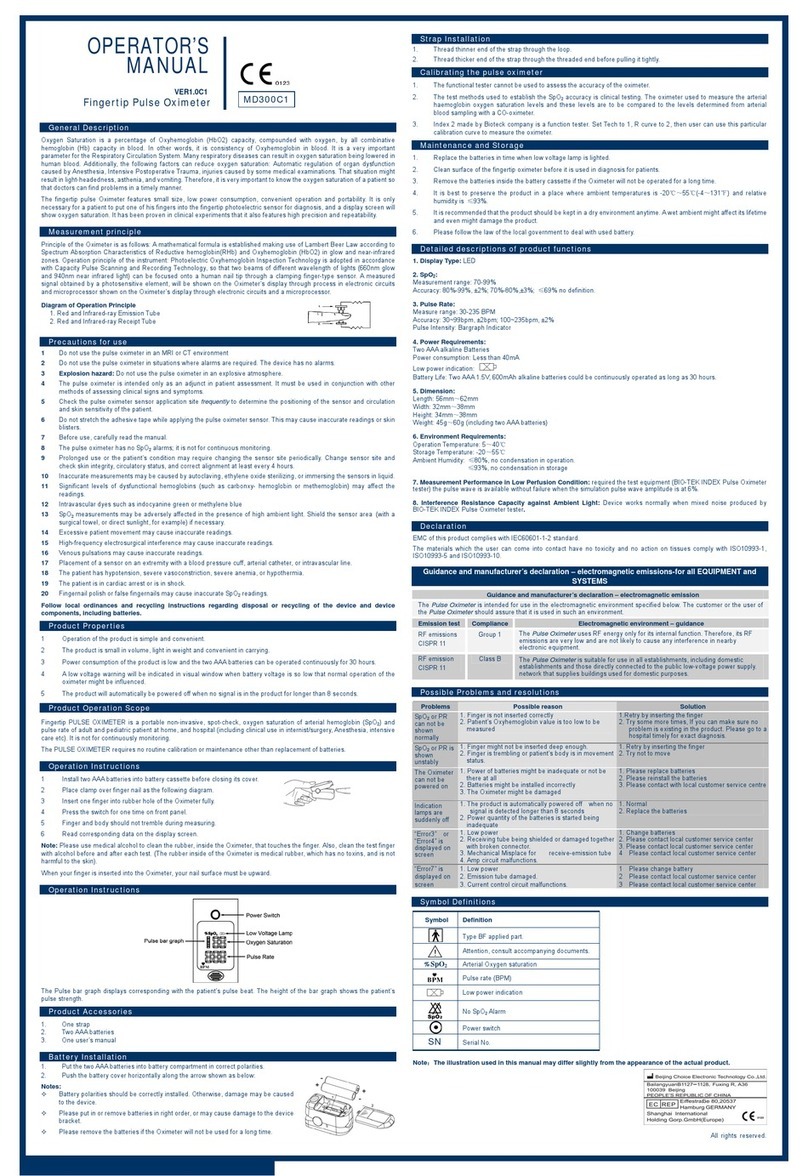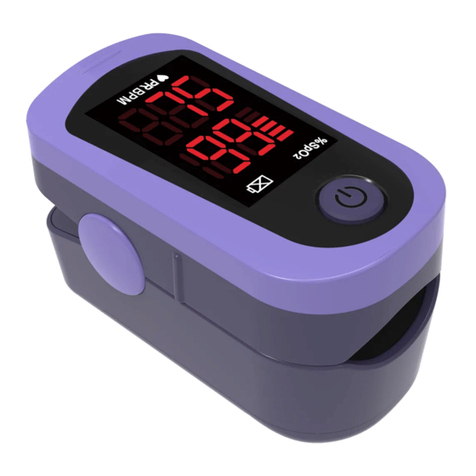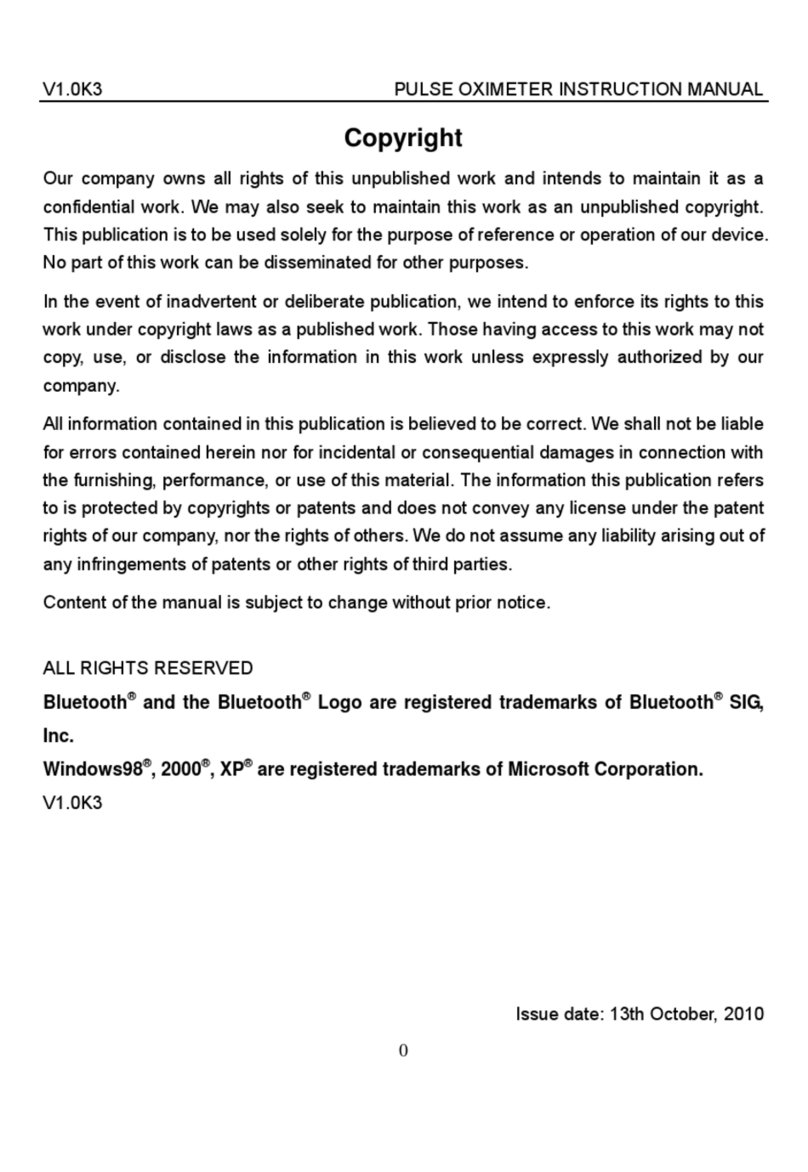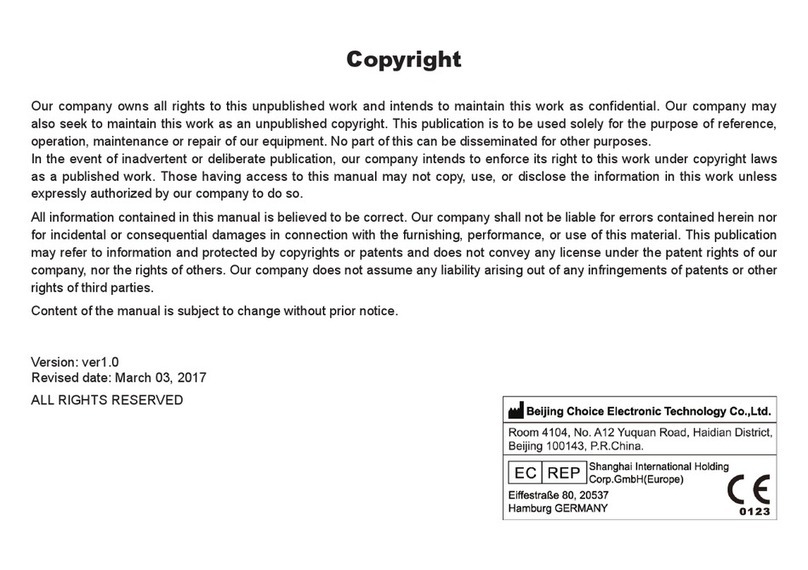OPERATOR'S
MANUAL
( E0123
I
MD300C2i
V3.0C2
Fingertip Pulse Oximeter
General Description '.-:-'. .
Oxygen Saturation is a percentage of Oxyhemoglobin (Hb02) capacity. compounded
with oxygen, by all combinative hemoglobin (Hb) capacity in blood. In other words, it is
consistency of Oxyhemoglobin in blood. It is a very important parameter for the
Respiratory Circulation System. Many respiratory diseases can result in oxygen
saturation being lowered in human blood. Additionally, the following factors can reduce
oxygen saturation: Automatic regulation of organ dysfunction caused by Anesthesia,
Intensive Postoperative Trauma, injuries caused by some medical examinations. That
situation might result in light-headedness, asthenia, and vomiting. Therefore, it is very
important to know the oxygen saturation of a patient so that doctors can find problems in
a timely manner.
The fingertip pulse Oximeter features small size, low power consumption, convenient
operation and portability. It is only necessary for a patient to put one of his fingers into
the fingertip photoelectric sensor for diagnosis, and a display screen will show oxygen
saturation. It has been proven in clinical experiments that it also features high precision
and repeatability.
Measurement principle--'-'
Principle of the Oximeter is as follows: A mathematical formula is established making
use of Lambert Beer Law according to Spectrum Absorption Characteristics of
Reductive hemoglobin(RHb) and Oxyhemoglobin (Hb02) in glow and near-infrared
zones. Operation principle of the instrument: Photoelectric Oxyhemoglobin Inspection
Technology is adopted in accordance with Capacity Pulse Scanning and Recording
Technology, so that two beams of different wavelength of lights (660nm glow and 940nm
near infrared light) can be focused onto a human nail tip through a clamping finger-type
sensor. A measured signal obtained by a photosensitive element, will be shown on the
Oximeter's display through process in electronic circuits and microprocessor shown on
the Oximeter's display through electronic circuits and a microprocessor.
~
~
Diagram of Operation Principle
1. Red and Infrared-ray Emission Tube
2..Red and rnfrared-ray Receipt Tube
Precautions for use
Do not use the pulse oximeter in an MRI or CT environment
2 Do not use the pulse oximeter in situations where alarms are required. The device
has no alarms.
3 Explosion hazard: Do not use the pulse oximeter in an explosive atmosphere.
4 The pulse oximeter is intended only as an adjunct in patient assessment. It must be
used in conjunction with other methods of assessinq clinical signs and symptoms.
5 Check the pulse oximeter sensor application site
frequently
to determine the
positioning of the sensor and circulation and skin sensitivity of the patient.
6' Do not stretch the adhesive tape while applying the pulse oximeter sensor. This may
cause inaccurate readings or skin blisters.
7 Before use, carefully read the manual.
8 The pulse oximeter has no Sp02 alarms; it is not for continuous monitoring.
9 Prolonged use or the patient's condition may require changing the sensor site
periodically. Change sensor site and check skin integrity, circulatory status, and
correct alignment at least every 4 hours.
10 Inaccurate measurements may be caused by autoclaving, ethylene oxide sterilizing,
or immersing the sensors in liquid.
11 Significant levels of dysfunctional hemoglobins (such as carbonxy- hemoglobin or
methemoglobin) may cause inaccurate readings.
12 Intravascular dyes such as indocyanine green or methylene blue.
13 Sp02 measurements may be adversely affected in the presence of high ambient light.
Shield the sensor area (with a surgical towel, or direct sunlight, for example) if
necessary.
14 Excessive patient movement may cause inaccurate readings.
15 Venous pulsations may cause inaccurate readings.
16 High-frequency electrosurgical interference may cause inaccurate readings.
17 Placement of a sensor on an extremity with a blood pressure cuff, arterial catheter, or
intravascular line.
18 The patient has hypotension, severe vasoconstriction, severe anemia, or
hypothermia.
19 The patient is in cardiac arrest or is in shock.
20 Fingernail polish or false fingernails may cause inaccurate Sp02 readings.
Follow local ordinances and recycling instructions regarding disposal or
recycling of the device and device components, including batteries.
Product Properties
Operation of the product is simple and convenient
The product is small in volume, light in weight and convenient in carrying.
Power consumption of the product is low and the two AAA batteries can be
operated continuously for 30 hours.
A low voltage warning will be indicated in visual window when battery voltage is
so low that normal operation of the oximeter might be influenced.
5 The product will automatically be powered off when no signal is in the product for
longer than
8
seconds.
1
2
3
4
Product Operation Scope
Fingertip PULSE OXIMETER is a portable non-invasive, spot-check, oxygen saturation
of arterial hemoglobin (Sp02) and pulse rate of adult and pediatric patient at home, and
hospital (including clinical use in intemisUsurgery, Anesthesia, intensive care etc). It is
not for continuously monitoring.
The PULSE OXIMETER requires no routine calibration or maintenance other than
replacement of batteries.
Operation Instructions
1 Install two AAA batteries into battery compartment correctly.
2 Place clamp over finger nail as the following diagram.
3 Insert one finger into rubber hole of the Oximeter fully.
4 Press the switch once on the front panel.
5
Finger and body should not tremble duringl'lleasuring.
6 Read correspondent data from display screen.
7Six display modes
After turning
on
the Oximeter each time you press the power switch the
Oximeter will switch to another display mode. There are
6
display modes shown
as
follows:
seo PR
SpO_ SpO,
PR_
95 84 97 74 198
I.
--
2.
~3.
'Ild
'OdS
PR
SpO,
'tld
L6
1
-...j
(,0
«:t
-...j
I'-
4. 5. 6.
When you press and hold the power switch for more than one second, the brightness of
the oximeter will be changed by degrees, there are 10 levels on brightness; the default
is level four.
NOTE: Please use medical alcohol to clean the rubber touching the finger inside of
Oximeter, and clean the test finger using alcohol before and after each test. (The rubber
inside of the Oximeter belongs medical rubber, which has no toxin and no harmful to the
skin).
When your finger is inserted into the Oximeter, your nail surface
must be upward.
Brief Description of Front Panel
Pulse bar graph
sp<n%
Waw/oml P~ Swi1dl
The Pulse bar graph displays corresponding with the patient's pulse beat. The height of
the bar graph shows the patient's pulse strength.
Product Accessories
1.
2.
3.
One strap
Two batteries
One user's manual
Battery Installation
Put the two AAA batteries into battery compartment in correct polarities.
2. Push the battery cover horizontally along the arrow shown as below:
Notes:
Battery polarities should be
installed. Otherwise, damage
caused to the device.
Please put in or remove batteries in right
order, or may cause damage to the device
bracket.
correctly
may be
Please remove the batteries if the Oximeter
will not be used for a long time.
























